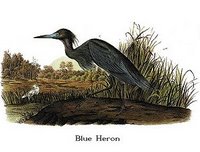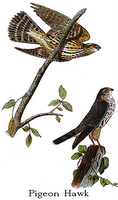Lifers
 134 little blue heron
134 little blue heronIt can take weeks to sort through my LBY fan mail, so apologies for not replying to a question about how many life birds I've seen this year. As a matter of fact, the day's little blue heron is just the latest. Seven of them (one a blotchy white juvenile) stalked their prey in a grassy pool at Eagle Bluffs, in the vicinity of a dozen or so great egrets and great blue herons.
Kingfishers also came out in force to angle the pools. One showed perfect hovering form crossing the water: three separate times during its flight it ascended to a hover and peered down at the water before moving on. On the next trip across it hovered again and plunged for a small fish.
Non-birds included my second bobcat in a month (head and shoulders poking from tall grass), a muskrat (swimming), and a four-foot-long black rat snake slowly winding up a tree, probably in search of a bird's nest.
I'm not sure how many life birds I have in 2006, since for some I can't remember if I've made past identifications. My best guess is 14: little blue heron, red-shouldered hawk, rough-legged hawk, solitary sandpiper, spotted sandpiper, Hudsonian godwit, Caspian tern, great crested flycatcher, warbling vireo, Swainson's thrush, worm-eating warbler, chipping sparrow, Savannah sparrow, great-tailed grackle.


